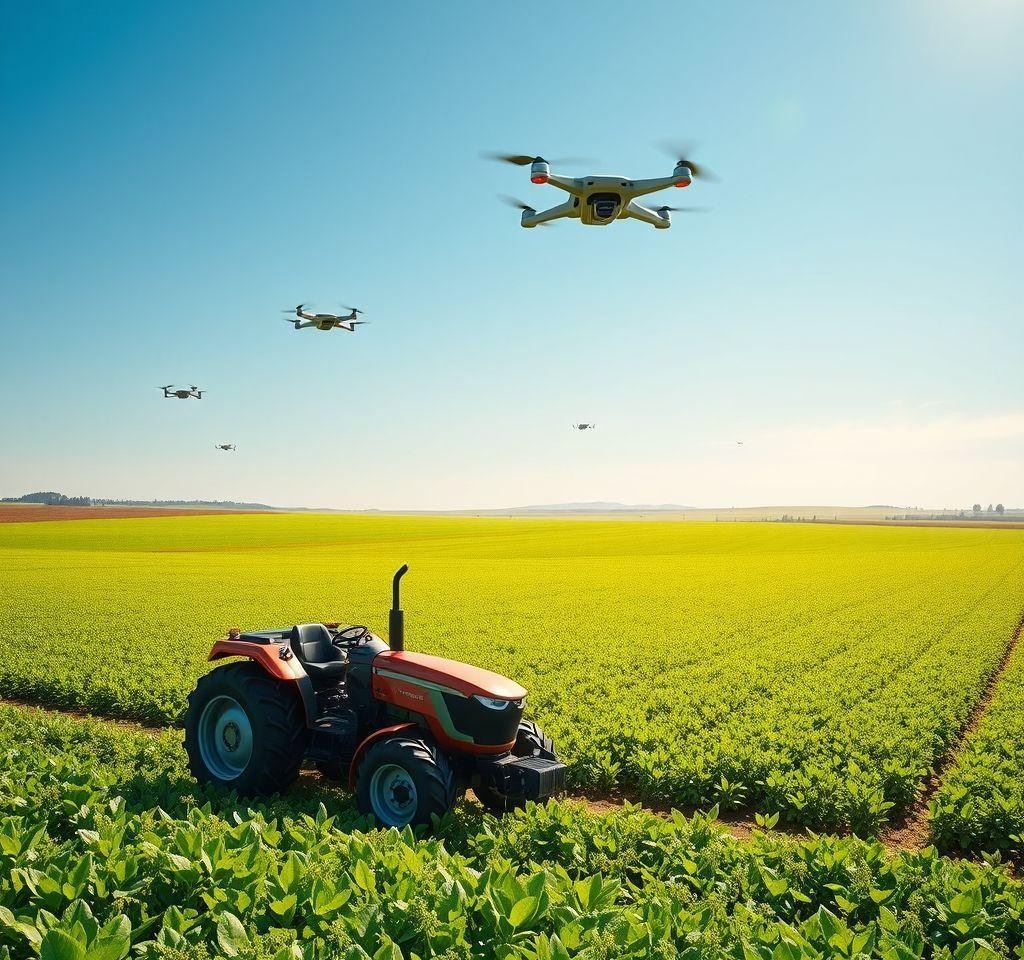AI and Environmental Conservation: Innovating Ecosystem Protection
As climate crises escalate, AI emerges as a transformative tool for environmental monitoring. From tracking endangered species to predicting deforestation hotspots, this article explores actionable AI applications and their impact on preserving biodiversity.
AI in Ecosystem Surveillance Systems
AI in Ecosystem Surveillance Systems
Advanced technologies are revolutionizing ecosystem monitoring. AI-driven sensors, deployed across diverse environments, collect real-time data. This includes information on animal populations, vegetation health, and pollution levels. These sensors feed data into sophisticated machine learning frameworks.
Drones equipped with high-resolution cameras and sensors provide aerial views. They monitor deforestation, track endangered species, and assess the impact of natural disasters. Data analysis using neural networks detects subtle changes, highlighting environmental threats.
Satellite imagery offers a broad perspective on environmental changes. AI algorithms analyze vast datasets, detecting patterns related to climate change, habitat loss, and pollution. This allows for rapid identification of areas requiring urgent intervention. Deep learning techniques enhance accuracy in detecting specific features like illegal logging or species migrations.
Data Analytics for Conservation Strategies
AI in Ecosystem Surveillance Systems
Advanced technologies are revolutionizing ecosystem monitoring. AI-driven sensors, deployed across diverse environments, collect real-time data. This includes information on animal populations, vegetation health, and pollution levels. These sensors feed data into sophisticated machine learning frameworks.
Drones equipped with high-resolution cameras and sensors provide aerial views. They monitor deforestation, track endangered species, and assess the impact of natural disasters. Data analysis using neural networks detects subtle changes, highlighting environmental threats.
Satellite imagery offers a broad perspective on environmental changes. AI algorithms analyze vast datasets, detecting patterns related to climate change, habitat loss, and pollution. This allows for rapid identification of areas requiring urgent intervention. Deep learning techniques enhance accuracy in detecting specific features like illegal logging or species migrations.
Global Case Studies: AI in Action
AI in Ecosystem Surveillance Systems
Advanced technologies are revolutionizing ecosystem monitoring. AI-driven sensors, deployed across diverse environments, collect real-time data. This includes information on animal populations, vegetation health, and pollution levels. These sensors feed data into sophisticated machine learning frameworks.
Drones equipped with high-resolution cameras and sensors provide aerial views. They monitor deforestation, track endangered species, and assess the impact of natural disasters. Data analysis using neural networks detects subtle changes, highlighting environmental threats.
Satellite imagery offers a broad perspective on environmental changes. AI algorithms analyze vast datasets, detecting patterns related to climate change, habitat loss, and pollution. This allows for rapid identification of areas requiring urgent intervention. Deep learning techniques enhance accuracy in detecting specific features like illegal logging or species migrations.
Overcoming Barriers in AI Adoption
AI in Ecosystem Surveillance Systems
Advanced technologies are revolutionizing ecosystem monitoring. AI-driven sensors, deployed across diverse environments, collect real-time data. This includes information on animal populations, vegetation health, and pollution levels. These sensors feed data into sophisticated machine learning frameworks.
Drones equipped with high-resolution cameras and sensors provide aerial views. They monitor deforestation, track endangered species, and assess the impact of natural disasters. Data analysis using neural networks detects subtle changes, highlighting environmental threats.
Satellite imagery offers a broad perspective on environmental changes. AI algorithms analyze vast datasets, detecting patterns related to climate change, habitat loss, and pollution. This allows for rapid identification of areas requiring urgent intervention. Deep learning techniques enhance accuracy in detecting specific features like illegal logging or species migrations.
Policy and AI Integration
AI in Ecosystem Surveillance Systems
Advanced technologies are revolutionizing ecosystem monitoring. AI-driven sensors, deployed across diverse environments, collect real-time data. This includes information on animal populations, vegetation health, and pollution levels. These sensors feed data into sophisticated machine learning frameworks.
Drones equipped with high-resolution cameras and sensors provide aerial views. They monitor deforestation, track endangered species, and assess the impact of natural disasters. Data analysis using neural networks detects subtle changes, highlighting environmental threats.
Satellite imagery offers a broad perspective on environmental changes. AI algorithms analyze vast datasets, detecting patterns related to climate change, habitat loss, and pollution. This allows for rapid identification of areas requiring urgent intervention. Deep learning techniques enhance accuracy in detecting specific features like illegal logging or species migrations.
AI in Ecosystem Surveillance Systems
Data Analytics for Conservation Strategies
AI is transforming conservation efforts by processing massive datasets. This allows for improved prediction of ecological changes. Algorithms analyze diverse data sources. These sources include climate data, species distribution maps, and human activity patterns.
Predictive modeling helps anticipate threats. For example, it can predict habitat loss or species decline. This allows for proactive conservation measures. Resource allocation becomes more efficient. Limited funds are focused on high-impact areas.
AI helps prioritize conservation zones. It identifies areas crucial for biodiversity. It considers factors like species richness and vulnerability. This allows for targeted protection efforts. Organizations use these insights for effective planning and management.
Several NGOs utilize predictive modeling. They successfully forecast potential threats. They can then mobilize resources accordingly. This helps in safeguarding vulnerable ecosystems and species. The results have been demonstrably positive in many cases.
Data Analytics for Conservation Strategies
Data Analytics for Conservation Strategies
AI is transforming conservation efforts by processing massive datasets. This allows for improved prediction of ecological changes. Algorithms analyze diverse data sources. These sources include climate data, species distribution maps, and human activity patterns.
Predictive modeling helps anticipate threats. For example, it can predict habitat loss or species decline. This allows for proactive conservation measures. Resource allocation becomes more efficient. Limited funds are focused on high-impact areas.
AI helps prioritize conservation zones. It identifies areas crucial for biodiversity. It considers factors like species richness and vulnerability. This allows for targeted protection efforts. Organizations use these insights for effective planning and management.
Several NGOs utilize predictive modeling. They successfully forecast potential threats. They can then mobilize resources accordingly. This helps in safeguarding vulnerable ecosystems and species. The results have been demonstrably positive in many cases.
Global Case Studies: AI in Action
Data Analytics for Conservation Strategies
AI is transforming conservation efforts by processing massive datasets. This allows for improved prediction of ecological changes. Algorithms analyze diverse data sources. These sources include climate data, species distribution maps, and human activity patterns.
Predictive modeling helps anticipate threats. For example, it can predict habitat loss or species decline. This allows for proactive conservation measures. Resource allocation becomes more efficient. Limited funds are focused on high-impact areas.
AI helps prioritize conservation zones. It identifies areas crucial for biodiversity. It considers factors like species richness and vulnerability. This allows for targeted protection efforts. Organizations use these insights for effective planning and management.
Several NGOs utilize predictive modeling. They successfully forecast potential threats. They can then mobilize resources accordingly. This helps in safeguarding vulnerable ecosystems and species. The results have been demonstrably positive in many cases.
Overcoming Barriers in AI Adoption
Data Analytics for Conservation Strategies
AI is transforming conservation efforts by processing massive datasets. This allows for improved prediction of ecological changes. Algorithms analyze diverse data sources. These sources include climate data, species distribution maps, and human activity patterns.
Predictive modeling helps anticipate threats. For example, it can predict habitat loss or species decline. This allows for proactive conservation measures. Resource allocation becomes more efficient. Limited funds are focused on high-impact areas.
AI helps prioritize conservation zones. It identifies areas crucial for biodiversity. It considers factors like species richness and vulnerability. This allows for targeted protection efforts. Organizations use these insights for effective planning and management.
Several NGOs utilize predictive modeling. They successfully forecast potential threats. They can then mobilize resources accordingly. This helps in safeguarding vulnerable ecosystems and species. The results have been demonstrably positive in many cases.
Policy and AI Integration
Data Analytics for Conservation Strategies
AI is transforming conservation efforts by processing massive datasets. This allows for improved prediction of ecological changes. Algorithms analyze diverse data sources. These sources include climate data, species distribution maps, and human activity patterns.
Predictive modeling helps anticipate threats. For example, it can predict habitat loss or species decline. This allows for proactive conservation measures. Resource allocation becomes more efficient. Limited funds are focused on high-impact areas.
AI helps prioritize conservation zones. It identifies areas crucial for biodiversity. It considers factors like species richness and vulnerability. This allows for targeted protection efforts. Organizations use these insights for effective planning and management.
Several NGOs utilize predictive modeling. They successfully forecast potential threats. They can then mobilize resources accordingly. This helps in safeguarding vulnerable ecosystems and species. The results have been demonstrably positive in many cases.
AI in Ecosystem Surveillance Systems
Global Case Studies: AI in Action
AI is rapidly transforming global conservation efforts. Several innovative projects demonstrate its impact. These projects showcase AI’s potential in protecting vulnerable ecosystems and species.
- One notable project involves the use of autonomous underwater drones. These drones monitor coral reefs. Image analysis algorithms detect coral bleaching and disease. This enables timely interventions to improve reef health. Real-time data provides crucial insights into reef ecosystem dynamics.
- Another impactful application is in anti-poaching efforts. Systems using thermal imaging cameras detect poachers at night. AI-powered alerts are sent to park rangers. This allows for rapid response and increased effectiveness in combating poaching. The technology reduces human intervention in dangerous situations.
- AI is also improving wildlife monitoring. Automated identification of species from camera trap images saves substantial time and resources. This enables more accurate population estimations and informed conservation decisions. Large datasets are analyzed to identify critical habitats and migration patterns.
These are just a few examples. AI-powered solutions offer innovative approaches to address pressing conservation challenges. The combination of advanced technologies and data analysis empowers conservationists to protect biodiversity worldwide.
Data Analytics for Conservation Strategies
Global Case Studies: AI in Action
AI is rapidly transforming global conservation efforts. Several innovative projects demonstrate its impact. These projects showcase AI’s potential in protecting vulnerable ecosystems and species.
- One notable project involves the use of autonomous underwater drones. These drones monitor coral reefs. Image analysis algorithms detect coral bleaching and disease. This enables timely interventions to improve reef health. Real-time data provides crucial insights into reef ecosystem dynamics.
- Another impactful application is in anti-poaching efforts. Systems using thermal imaging cameras detect poachers at night. AI-powered alerts are sent to park rangers. This allows for rapid response and increased effectiveness in combating poaching. The technology reduces human intervention in dangerous situations.
- AI is also improving wildlife monitoring. Automated identification of species from camera trap images saves substantial time and resources. This enables more accurate population estimations and informed conservation decisions. Large datasets are analyzed to identify critical habitats and migration patterns.
These are just a few examples. AI-powered solutions offer innovative approaches to address pressing conservation challenges. The combination of advanced technologies and data analysis empowers conservationists to protect biodiversity worldwide.
Global Case Studies: AI in Action
Global Case Studies: AI in Action
AI is rapidly transforming global conservation efforts. Several innovative projects demonstrate its impact. These projects showcase AI’s potential in protecting vulnerable ecosystems and species.
- One notable project involves the use of autonomous underwater drones. These drones monitor coral reefs. Image analysis algorithms detect coral bleaching and disease. This enables timely interventions to improve reef health. Real-time data provides crucial insights into reef ecosystem dynamics.
- Another impactful application is in anti-poaching efforts. Systems using thermal imaging cameras detect poachers at night. AI-powered alerts are sent to park rangers. This allows for rapid response and increased effectiveness in combating poaching. The technology reduces human intervention in dangerous situations.
- AI is also improving wildlife monitoring. Automated identification of species from camera trap images saves substantial time and resources. This enables more accurate population estimations and informed conservation decisions. Large datasets are analyzed to identify critical habitats and migration patterns.
These are just a few examples. AI-powered solutions offer innovative approaches to address pressing conservation challenges. The combination of advanced technologies and data analysis empowers conservationists to protect biodiversity worldwide.
Overcoming Barriers in AI Adoption
Global Case Studies: AI in Action
AI is rapidly transforming global conservation efforts. Several innovative projects demonstrate its impact. These projects showcase AI’s potential in protecting vulnerable ecosystems and species.
- One notable project involves the use of autonomous underwater drones. These drones monitor coral reefs. Image analysis algorithms detect coral bleaching and disease. This enables timely interventions to improve reef health. Real-time data provides crucial insights into reef ecosystem dynamics.
- Another impactful application is in anti-poaching efforts. Systems using thermal imaging cameras detect poachers at night. AI-powered alerts are sent to park rangers. This allows for rapid response and increased effectiveness in combating poaching. The technology reduces human intervention in dangerous situations.
- AI is also improving wildlife monitoring. Automated identification of species from camera trap images saves substantial time and resources. This enables more accurate population estimations and informed conservation decisions. Large datasets are analyzed to identify critical habitats and migration patterns.
These are just a few examples. AI-powered solutions offer innovative approaches to address pressing conservation challenges. The combination of advanced technologies and data analysis empowers conservationists to protect biodiversity worldwide.
Policy and AI Integration
Global Case Studies: AI in Action
AI is rapidly transforming global conservation efforts. Several innovative projects demonstrate its impact. These projects showcase AI’s potential in protecting vulnerable ecosystems and species.
- One notable project involves the use of autonomous underwater drones. These drones monitor coral reefs. Image analysis algorithms detect coral bleaching and disease. This enables timely interventions to improve reef health. Real-time data provides crucial insights into reef ecosystem dynamics.
- Another impactful application is in anti-poaching efforts. Systems using thermal imaging cameras detect poachers at night. AI-powered alerts are sent to park rangers. This allows for rapid response and increased effectiveness in combating poaching. The technology reduces human intervention in dangerous situations.
- AI is also improving wildlife monitoring. Automated identification of species from camera trap images saves substantial time and resources. This enables more accurate population estimations and informed conservation decisions. Large datasets are analyzed to identify critical habitats and migration patterns.
These are just a few examples. AI-powered solutions offer innovative approaches to address pressing conservation challenges. The combination of advanced technologies and data analysis empowers conservationists to protect biodiversity worldwide.
AI in Ecosystem Surveillance Systems
Overcoming Barriers in AI Adoption
While AI offers transformative potential for environmental conservation, several barriers hinder its widespread adoption. Data accessibility is a major challenge. Many crucial datasets are fragmented, incomplete, or inaccessible. This limits the development and application of effective AI models.
Significant cost barriers also exist. Developing and deploying AI systems requires substantial investment in hardware, software, and skilled personnel. This financial constraint restricts access for many conservation organizations, particularly smaller NGOs with limited budgets.
Ethical considerations are paramount. Concerns exist regarding data privacy, algorithmic bias, and unintended consequences. Responsible AI development requires careful attention to these issues, ensuring fairness and minimizing potential harm. Transparency and accountability are key elements in addressing ethical challenges.
Solutions are emerging to overcome these challenges. Open-source platforms promote collaboration and reduce the cost of AI development. These platforms facilitate the sharing of data and algorithms, making AI technology more accessible. Public-private partnerships leverage resources from various sectors, fostering innovation and accelerating AI adoption in conservation.
Data Analytics for Conservation Strategies
Overcoming Barriers in AI Adoption
While AI offers transformative potential for environmental conservation, several barriers hinder its widespread adoption. Data accessibility is a major challenge. Many crucial datasets are fragmented, incomplete, or inaccessible. This limits the development and application of effective AI models.
Significant cost barriers also exist. Developing and deploying AI systems requires substantial investment in hardware, software, and skilled personnel. This financial constraint restricts access for many conservation organizations, particularly smaller NGOs with limited budgets.
Ethical considerations are paramount. Concerns exist regarding data privacy, algorithmic bias, and unintended consequences. Responsible AI development requires careful attention to these issues, ensuring fairness and minimizing potential harm. Transparency and accountability are key elements in addressing ethical challenges.
Solutions are emerging to overcome these challenges. Open-source platforms promote collaboration and reduce the cost of AI development. These platforms facilitate the sharing of data and algorithms, making AI technology more accessible. Public-private partnerships leverage resources from various sectors, fostering innovation and accelerating AI adoption in conservation.
Global Case Studies: AI in Action
Overcoming Barriers in AI Adoption
While AI offers transformative potential for environmental conservation, several barriers hinder its widespread adoption. Data accessibility is a major challenge. Many crucial datasets are fragmented, incomplete, or inaccessible. This limits the development and application of effective AI models.
Significant cost barriers also exist. Developing and deploying AI systems requires substantial investment in hardware, software, and skilled personnel. This financial constraint restricts access for many conservation organizations, particularly smaller NGOs with limited budgets.
Ethical considerations are paramount. Concerns exist regarding data privacy, algorithmic bias, and unintended consequences. Responsible AI development requires careful attention to these issues, ensuring fairness and minimizing potential harm. Transparency and accountability are key elements in addressing ethical challenges.
Solutions are emerging to overcome these challenges. Open-source platforms promote collaboration and reduce the cost of AI development. These platforms facilitate the sharing of data and algorithms, making AI technology more accessible. Public-private partnerships leverage resources from various sectors, fostering innovation and accelerating AI adoption in conservation.
Overcoming Barriers in AI Adoption
Overcoming Barriers in AI Adoption
While AI offers transformative potential for environmental conservation, several barriers hinder its widespread adoption. Data accessibility is a major challenge. Many crucial datasets are fragmented, incomplete, or inaccessible. This limits the development and application of effective AI models.
Significant cost barriers also exist. Developing and deploying AI systems requires substantial investment in hardware, software, and skilled personnel. This financial constraint restricts access for many conservation organizations, particularly smaller NGOs with limited budgets.
Ethical considerations are paramount. Concerns exist regarding data privacy, algorithmic bias, and unintended consequences. Responsible AI development requires careful attention to these issues, ensuring fairness and minimizing potential harm. Transparency and accountability are key elements in addressing ethical challenges.
Solutions are emerging to overcome these challenges. Open-source platforms promote collaboration and reduce the cost of AI development. These platforms facilitate the sharing of data and algorithms, making AI technology more accessible. Public-private partnerships leverage resources from various sectors, fostering innovation and accelerating AI adoption in conservation.
Policy and AI Integration
Overcoming Barriers in AI Adoption
While AI offers transformative potential for environmental conservation, several barriers hinder its widespread adoption. Data accessibility is a major challenge. Many crucial datasets are fragmented, incomplete, or inaccessible. This limits the development and application of effective AI models.
Significant cost barriers also exist. Developing and deploying AI systems requires substantial investment in hardware, software, and skilled personnel. This financial constraint restricts access for many conservation organizations, particularly smaller NGOs with limited budgets.
Ethical considerations are paramount. Concerns exist regarding data privacy, algorithmic bias, and unintended consequences. Responsible AI development requires careful attention to these issues, ensuring fairness and minimizing potential harm. Transparency and accountability are key elements in addressing ethical challenges.
Solutions are emerging to overcome these challenges. Open-source platforms promote collaboration and reduce the cost of AI development. These platforms facilitate the sharing of data and algorithms, making AI technology more accessible. Public-private partnerships leverage resources from various sectors, fostering innovation and accelerating AI adoption in conservation.
AI in Ecosystem Surveillance Systems
Policy and AI Integration
Governments and technology companies are increasingly collaborating to leverage AI for environmental protection. This partnership aids in enforcing environmental regulations and achieving long-term sustainability goals. Effective collaboration is crucial for success.
AI-powered systems analyze vast datasets. This allows for the detection of illegal activities. Examples include deforestation or pollution violations. Real-time monitoring improves enforcement efficiency. This minimizes environmental damage.
The integration of AI into policy frameworks enhances transparency and accountability. Data-driven decision-making leads to more effective resource allocation. It also leads to more impactful conservation initiatives. Long-term sustainability requires sustained commitment and collaboration.
One example of this collaboration is evidenced by initiatives mirroring the EU Biodiversity Strategy. These efforts combine policy frameworks with AI-powered monitoring tools. This results in better protection of ecosystems and biodiversity. The focus is on long-term environmental sustainability.
Data Analytics for Conservation Strategies
Policy and AI Integration
Governments and technology companies are increasingly collaborating to leverage AI for environmental protection. This partnership aids in enforcing environmental regulations and achieving long-term sustainability goals. Effective collaboration is crucial for success.
AI-powered systems analyze vast datasets. This allows for the detection of illegal activities. Examples include deforestation or pollution violations. Real-time monitoring improves enforcement efficiency. This minimizes environmental damage.
The integration of AI into policy frameworks enhances transparency and accountability. Data-driven decision-making leads to more effective resource allocation. It also leads to more impactful conservation initiatives. Long-term sustainability requires sustained commitment and collaboration.
One example of this collaboration is evidenced by initiatives mirroring the EU Biodiversity Strategy. These efforts combine policy frameworks with AI-powered monitoring tools. This results in better protection of ecosystems and biodiversity. The focus is on long-term environmental sustainability.
Global Case Studies: AI in Action
Policy and AI Integration
Governments and technology companies are increasingly collaborating to leverage AI for environmental protection. This partnership aids in enforcing environmental regulations and achieving long-term sustainability goals. Effective collaboration is crucial for success.
AI-powered systems analyze vast datasets. This allows for the detection of illegal activities. Examples include deforestation or pollution violations. Real-time monitoring improves enforcement efficiency. This minimizes environmental damage.
The integration of AI into policy frameworks enhances transparency and accountability. Data-driven decision-making leads to more effective resource allocation. It also leads to more impactful conservation initiatives. Long-term sustainability requires sustained commitment and collaboration.
One example of this collaboration is evidenced by initiatives mirroring the EU Biodiversity Strategy. These efforts combine policy frameworks with AI-powered monitoring tools. This results in better protection of ecosystems and biodiversity. The focus is on long-term environmental sustainability.
Overcoming Barriers in AI Adoption
Policy and AI Integration
Governments and technology companies are increasingly collaborating to leverage AI for environmental protection. This partnership aids in enforcing environmental regulations and achieving long-term sustainability goals. Effective collaboration is crucial for success.
AI-powered systems analyze vast datasets. This allows for the detection of illegal activities. Examples include deforestation or pollution violations. Real-time monitoring improves enforcement efficiency. This minimizes environmental damage.
The integration of AI into policy frameworks enhances transparency and accountability. Data-driven decision-making leads to more effective resource allocation. It also leads to more impactful conservation initiatives. Long-term sustainability requires sustained commitment and collaboration.
One example of this collaboration is evidenced by initiatives mirroring the EU Biodiversity Strategy. These efforts combine policy frameworks with AI-powered monitoring tools. This results in better protection of ecosystems and biodiversity. The focus is on long-term environmental sustainability.
Policy and AI Integration
Policy and AI Integration
Governments and technology companies are increasingly collaborating to leverage AI for environmental protection. This partnership aids in enforcing environmental regulations and achieving long-term sustainability goals. Effective collaboration is crucial for success.
AI-powered systems analyze vast datasets. This allows for the detection of illegal activities. Examples include deforestation or pollution violations. Real-time monitoring improves enforcement efficiency. This minimizes environmental damage.
The integration of AI into policy frameworks enhances transparency and accountability. Data-driven decision-making leads to more effective resource allocation. It also leads to more impactful conservation initiatives. Long-term sustainability requires sustained commitment and collaboration.
One example of this collaboration is evidenced by initiatives mirroring the EU Biodiversity Strategy. These efforts combine policy frameworks with AI-powered monitoring tools. This results in better protection of ecosystems and biodiversity. The focus is on long-term environmental sustainability.
Final Words
AI empowers conservationists to act decisively through real-time insights, predictive analytics, and global collaboration. By integrating AI into ecological frameworks, humanity can achieve measurable progress toward sustainable ecosystems.




